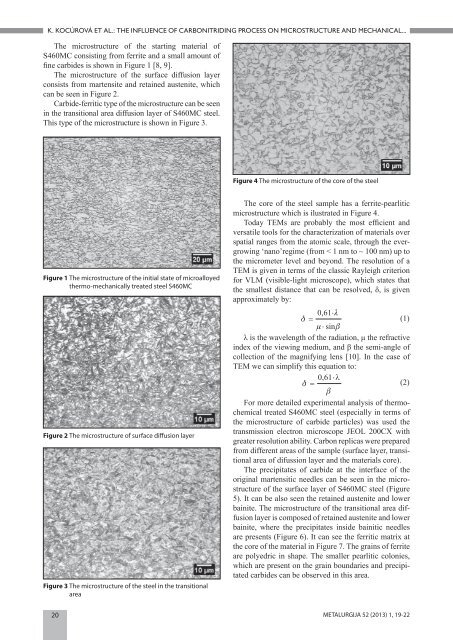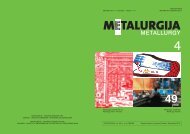Metalurgija: sadašnjost Metallurgy: Present Metalurgija ... - CARNet
Metalurgija: sadašnjost Metallurgy: Present Metalurgija ... - CARNet
Metalurgija: sadašnjost Metallurgy: Present Metalurgija ... - CARNet
You also want an ePaper? Increase the reach of your titles
YUMPU automatically turns print PDFs into web optimized ePapers that Google loves.
K. KOCÚROVÁ ET AL.: THE INFLUENCE OF CARBONITRIDING PROCESS ON MICROSTRUCTURE AND MECHANICAL...<br />
The microstructure of the starting material of<br />
S460MC consisting from ferrite and a small amount of<br />
fi ne carbides is shown in Figure 1 [8, 9].<br />
The microstructure of the surface diffusion layer<br />
consists from martensite and retained austenite, which<br />
can be seen in Figure 2.<br />
Carbide-ferritic type of the microstructure can be seen<br />
in the transitional area diffusion layer of S460MC steel.<br />
This type of the microstructure is shown in Figure 3.<br />
Figure 1 The microstructure of the initial state of microalloyed<br />
thermo-mechanically treated steel S460MC<br />
Figure 2 The microstructure of surface diff usion layer<br />
Figure 3 The microstructure of the steel in the transitional<br />
area<br />
Figure 4 The microstructure of the core of the steel<br />
The core of the steel sample has a ferrite-pearlitic<br />
microstructure which is ilustrated in Figure 4.<br />
Today TEMs are probably the most effi cient and<br />
versatile tools for the characterization of materials over<br />
spatial ranges from the atomic scale, through the evergrowing<br />
‘nano’regime (from < 1 nm to ~ 100 nm) up to<br />
the micrometer level and beyond. The resolution of a<br />
TEM is given in terms of the classic Rayleigh criterion<br />
for VLM (visible-light microscope), which states that<br />
the smallest distance that can be resolved, δ, is given<br />
approximately by:<br />
0,61⋅λ<br />
δ = (1)<br />
µ ⋅ sinβ<br />
λ is the wavelength of the radiation, μ the refractive<br />
index of the viewing medium, and β the semi-angle of<br />
collection of the magnifying lens [10]. In the case of<br />
TEM we can simplify this equation to:<br />
⋅<br />
δ =<br />
β<br />
0,61<br />
(2)<br />
For more detailed experimental analysis of thermochemical<br />
treated S460MC steel (especially in terms of<br />
the microstructure of carbide particles) was used the<br />
transmission electron microscope JEOL 200CX with<br />
greater resolution ability. Carbon replicas were prepared<br />
from different areas of the sample (surface layer, transitional<br />
area of difussion layer and the materials core).<br />
The precipitates of carbide at the interface of the<br />
original martensitic needles can be seen in the microstructure<br />
of the surface layer of S460MC steel (Figure<br />
5). It can be also seen the retained austenite and lower<br />
bainite. The microstructure of the transitional area diffusion<br />
layer is composed of retained austenite and lower<br />
bainite, where the precipitates inside bainitic needles<br />
are presents (Figure 6). It can see the ferritic matrix at<br />
the core of the material in Figure 7. The grains of ferrite<br />
are polyedric in shape. The smaller pearlitic colonies,<br />
which are present on the grain boundaries and precipitated<br />
carbides can be observed in this area.<br />
20 METALURGIJA 52 (2013) 1, 19-22
















